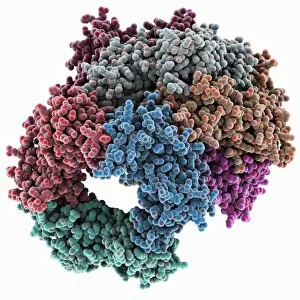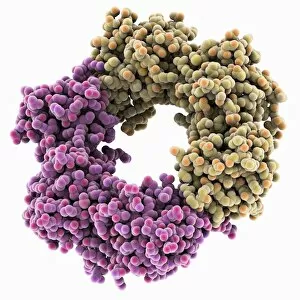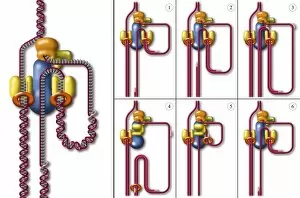Sliding Clamp Collection
"Unlocking the Secrets of DNA: The Sliding Clamp Revealed" In the intricate world of genetics, a remarkable molecular player takes center stage - the sliding clamp
All Professionally Made to Order for Quick Shipping
"Unlocking the Secrets of DNA: The Sliding Clamp Revealed" In the intricate world of genetics, a remarkable molecular player takes center stage - the sliding clamp. This captivating protein, known as proliferating cell nuclear antigen (PCNA), forms an essential complex with DNA molecules to ensure accurate replication and repair processes. Imagine a microscopic scene where PCNA embraces a DNA molecule like a protective shield. This dynamic interaction creates an unbreakable bond, allowing for efficient movement along the double helix during replication. Together, they form an inseparable duo that safeguards our genetic information. Within this fascinating realm, specific combinations arise - such as the DNA clamp complexed with DNA molecule F006 / 9732 or F006 / 9274. These unique partnerships showcase how PCNA adapts to different sequences and structures within our genome, ensuring precision in every step. But PCNA doesn't work alone; it recruits its faithful companions – the DNA polymerase III subunit molecules. Like diligent workers on an assembly line, these subunits collaborate harmoniously with PCNA to synthesize new strands of DNA accurately and efficiently. The sliding clamp's role goes beyond mere replication; it also aids in repairing damaged sections of our genetic code. When confronted with errors or lesions in our DNA sequence, PCNA steps up its game by partnering with specific molecules like C016 / 2328 or C016 / 2329. Together, they orchestrate intricate repair mechanisms that maintain genomic stability. As we delve deeper into understanding this extraordinary molecular machinery, scientists uncover more about how these components interact flawlessly to preserve life's blueprint. Their discoveries shed light on diseases caused by faulty replication or impaired repair processes and offer hope for targeted treatments in the future. So next time you marvel at nature's complexity or ponder your own existence, remember the silent hero working tirelessly behind the scenes – the sliding clamp orchestrating precise movements along our precious strands of DNA.









